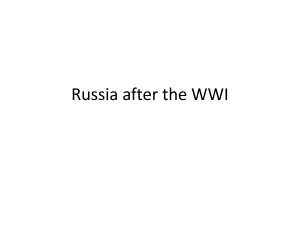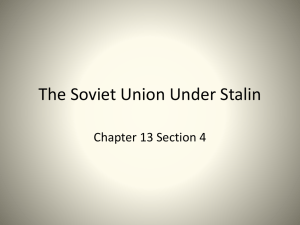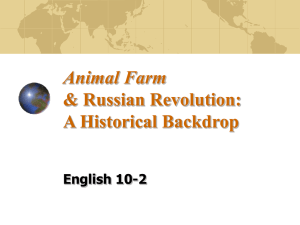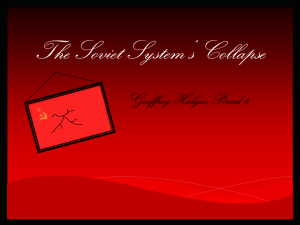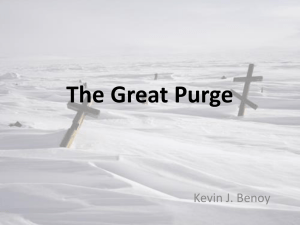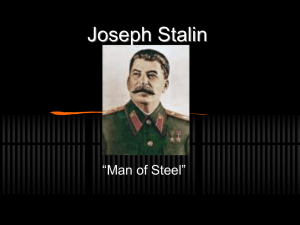Ch 13 Sec 4 Soviet union under stalin Waterson
advertisement
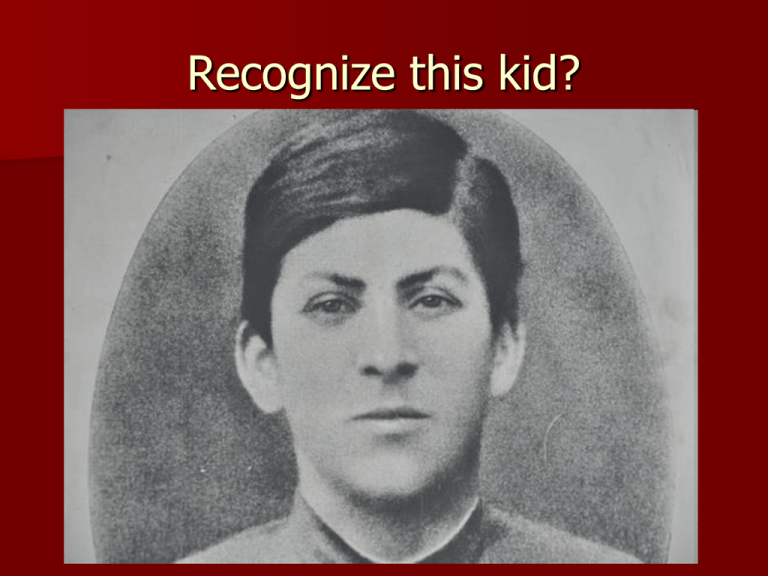
Recognize this kid? Source R: The Stalinist Constitution QW What can you infer about Stalin’s leadership of the Soviet Union? Source S: Propaganda in Stalinist Russia QW What does this source tell you about Stalin? Joseph Stalin Man of Steel Lenin and Stalin Aleksei Vasiliev Lenin and Stalin in Summer 1917 Ivan Vladimirov Stalin Totalitarian State Stalin would take power after the death of Lenin in 1924. He turned the Soviet Union into a Totalitarian State. Stalin’s Five-Year Plans *Main purpose was to build heavy industry & increase farm output. *All economic activity was brought under gov’t control - command economy was developed. Five-Year Plans cont’d Though output increased the standard of living remained low. *Wages were low & workers were forbidden to strike. Government control of agriculture Collectives: large farms owned and operated by peasants as a group State set prices and access to supplies Peasants who did not want to give up their land resisted the collectives. Collectivization of farms Individual farms Each has own farmhouse Tractor Equipment etc Farmers make $ based on how productive they are. The more productive, the more $ they make. Workers live in communal village, in govt housing projects Collective farm – state (government) owned, all equipment and Housing, pooled together. Everyone gets paid the same wages. All profits go to government, which then pays the workers. No incentive, no ownership of land Stalin blamed kulaks, wealthy farmers, for resistance Land confiscated Millions were killed outright or sent to forced-labor camps to suffer a slow death. "We farmers, on the basis of complete collectivization, will liquidate the kulaks as a class." Terror Famine Angry peasants resisted collectivization by growing just enough to feed themselves. – In response the gov’t seized all their grain and purposefully left them to starve. In 1932 this ruthless policy led to the Terror Famine-between 5 & 8 million people died in the Ukraine alone. Stalin’s Terror Tactics Stalin ruthlessly used terror as a weapon against his own people. He committed crimes against humanity and violated his people’s individual rights. Critics were sent to the Gulag (a system of brutal labor camps where many died). Hard / Physical Labor Food was in short supply Maria Tchebotareva Trying to feed her four hungry children during the massive 1932-1933 famine, the peasant mother allegedly stole three pounds of rye from her former field—confiscated by the state as part of collectivization. Soviet authorities sentenced her to ten years in the Gulag. When her sentence expired in 1943, it was arbitrarily extended until the end of the war in 1945. After her release, she was required to live in exile near her Gulag camp north of the Arctic Circle, and she was not able to return home until 1956, after the death of Stalin. Maria Tchebotareva never found her children after her release. Ivan Burylov Seeking the appearance of democracy, the Soviet Union held elections, but only one Communist Party candidate appeared on the ballot for each office. Fear of punishment ensured that nearly all Soviet citizens “voted” by taking their ballot and ceremoniously placing it into a ballot box. In 1949, Ivan Burylov, a beekeeper, protested this absurd ritual by writing the word “Comedy” on his “secret” ballot. Soviet authorities linked the ballot to Burylov and sentenced him to eight years in camps for this “crime.” The country had virtually become a labor camp Stalin’s Terror Tactics Great Purge (policy created by Stalin in which he eliminated rival party leaders and old Bolsheviks). –Started in 1934 –At least 4 million people were purged (killed) during the Stalin years. This puts the USSR in a bad position when it comes time to fight WWII, since Stalin liquidated many officers in the military… Bodies were simply piled up to be buried in a mass grave Stalin promoted atheism (the belief there is no god) as the official state policy…communism is your god. Attempts to Control Thought Propaganda-the attempt to boost morale & faith in the communist party by making himself (Stalin) a godlike figure. Soviet Propaganda Poster “Look Me in the Eyes and Tell Me Honestly: Who is your friend? Who is your enemy? You have no friends among capitalists. You have no enemies among the workers. Only in a union of the workers of all nations will you be victorious over capitalism and liberated from exploitation. Down with national antagonisms! Workers of the world unite!” "To whom goes all national profits? In the CCCP, to the workers." “Love Your Motherland” IN DECEMBER 1934, Sergey Kirov, a prominent early Bolshevik leader and loyal supporter of Joseph Stalin, was assassinated… a purge… …Stalin had ordered the execution. Attempts to Control Thought Socialist Realism-Goal to show Soviet life in a positive light & promote communism. – The following works of art illustrate socialist realism… The Leaders: The Cult of Personality Lenin in Front of the Globe Vladimir Sinitsky Lenin Aleksei Nesterenko, 1938 Lenin German Tatarinov, 1950s Lenin at the Kremlin Ivan Petrenko Lenin in his Study Nikolai Pavliuk, 1947 Lenin at the Smolny Institute Isaak Brodsky, 1930 Portrait of Stalin Aleksandr Laktionov, 1945 Stalin Aleksei Vasiliev Stalin Grigory Shpoliansky, 1949 Stalin Konstantin Lomykin, 1949 Karl Marx Konstantin Kamyshni Karl Marx Aleksandr Krylov The Guiding Role of the Party Vladimir Ilich Lenin Vasily Ivanov Lenin With Farmers Viacheslav Tokarev, c. 1960 Lenin with Villagers Evdokiya Usikova, 1959 Gorky Reading to Stalin Viktor Govorov, 1940 Stalin as Organizer of the October Revolution Karp Trokhimenko Stalin at a Political Meeting at the Kremlin Sergei Grigoriev Stalin at the 8th Party Conference Petr Parkhets Adoration of the Leaders Lenin’s Arrival at Finland Station Arkady Rusin On the Battlefield Lenin on the Airfield Boris Vladimirsky, 1930 Stalin in the Civil War Mikhail Bozhi, 1950 Trumpeters of the First Cavalry Mitrofan Grekov, 1934 The 1917 Revolution Karp Trokhimenko The Return of the Victors Vasily Saicenko, 1953 Industry Stalin and Kirov Visit the Volkhov Hydrostation Karp Trokhimenko In the Stalin Factory Mikhail Kostinin Steel Workers V. Malagis, 1950 Miner Boris Vladimirsky, 1929 Agriculture and Education The First Tractor Vladimir Krikhatsky Female Worker Boris Vladimirsky In a Girls’ School Ivan Vladimirov Communist Moscow The Kremlin Aleksei Putayev Moscow State University Mukhina’s Monument Aleksei Shovkunenko Soviet Society Benefits Free schooling Programs outside of school (sports) Free medical care Inexpensive housing Public recreation Drawbacks Taught communist values (atheism, glory of collective farming, love of Stalin) Housing scarce Most food in short supply Russification Attempts to make the nations culture more Russian. 11 Soviet Republics Old Russian heartland the largest and most dominant. Attempt to overwhelm the other cultures in the USSR.

